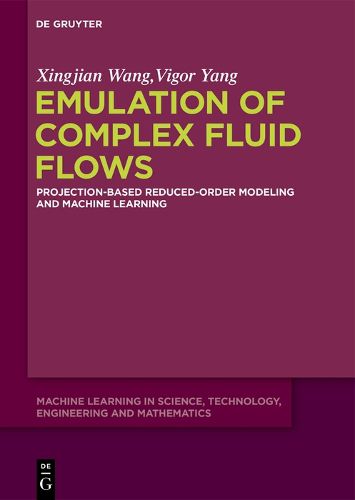Readings Newsletter
Become a Readings Member to make your shopping experience even easier.
Sign in or sign up for free!
You’re not far away from qualifying for FREE standard shipping within Australia
You’ve qualified for FREE standard shipping within Australia
The cart is loading…






While artificial intelligence has made significant strides in imaging and natural language processing, its utilization in engineering science remains relatively new. This book aims to introduce machine learning techniques to facilitate the emulation of complex fluid flows. The work focuses on projection-based reduced-order models (ROMs) that condense high-dimensional data into a low-dimensional subspace by leveraging principal components. Techniques like proper orthogonal decomposition (POD) and convolutional autoencoder (CAE) are utilized to configure this subspace, establishing a functional mapping between input parameters and solution fields. The applicability of POD-based ROMs for spatial and spatiotemporal problems are explored across various engineering scenarios, including flow past a cylinder, supercritical turbulent flows, and hydrogen-blended combustion. To capture intricate dynamics, common POD, kernel-smoothed POD, and common kernel-smoothed POD methods are developed in sequence. Additionally, the effectiveness of POD and CAE in capturing nonlinear features are compared. This book is designed to benefit graduate students and researchers interested in the intersection of data and engineering sciences.
$9.00 standard shipping within Australia
FREE standard shipping within Australia for orders over $100.00
Express & International shipping calculated at checkout
While artificial intelligence has made significant strides in imaging and natural language processing, its utilization in engineering science remains relatively new. This book aims to introduce machine learning techniques to facilitate the emulation of complex fluid flows. The work focuses on projection-based reduced-order models (ROMs) that condense high-dimensional data into a low-dimensional subspace by leveraging principal components. Techniques like proper orthogonal decomposition (POD) and convolutional autoencoder (CAE) are utilized to configure this subspace, establishing a functional mapping between input parameters and solution fields. The applicability of POD-based ROMs for spatial and spatiotemporal problems are explored across various engineering scenarios, including flow past a cylinder, supercritical turbulent flows, and hydrogen-blended combustion. To capture intricate dynamics, common POD, kernel-smoothed POD, and common kernel-smoothed POD methods are developed in sequence. Additionally, the effectiveness of POD and CAE in capturing nonlinear features are compared. This book is designed to benefit graduate students and researchers interested in the intersection of data and engineering sciences.